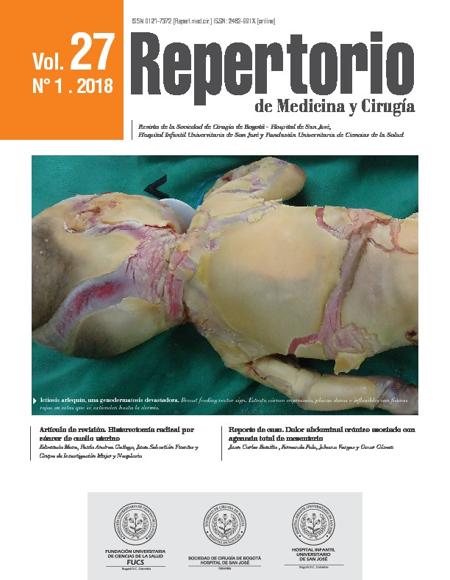Histerectomía radical por cáncer de cuello uterino
Radical hysterectomy cervical cancer
Esta obra está bajo una licencia internacional Creative Commons Atribución-NoComercial-CompartirIgual 4.0.
Mostrar biografía de los autores
Objetivo: describir los resultados postoperatorios de las pacientes sometidas a histerectomía radical por cáncer de cuello uterino entre junio 2007 y junio 2017 en el Hospital de San José de Bogotá. Materiales y métodos: revisión retrospectiva de las histerectomías radicales por vía abierta realizadas por cáncer de cuello uterino en estadios de la FIGO (International Federation of Gynecology and Obstetrics) IA2 a IIA1. Se incluyeron variables de tipo clínico, anatomopatológico y complicaciones. Resultados: en total fueron 70 pacientes con promedio de edad de 45.5 años (DE 11.1). Los tipos histológicos corresponden a escamocelular (n= 59, 84.3%) y adenocarcinoma (n=11, 15.7%). El sangrado intraoperatorio promedio fue de 700 cc (rango: 50-1000, la tasa de transfusión fue 12.9% (9 pacientes). Hubo complicaciones intraoperatorias en 7 (9.9%), 5 lesiones vasculares, una lesión del ureter y otra de la serosa del sigmoide. Se detectó compromiso de bordes en siete (10%), metástasis ganglionar en 5 pacientes (8.6%) y lesión parametrial en 3 (4.3%). El tamaño tumoral fue < 2 cm en 42 pacientes (60%), invasión estromal <1/3 en 42 (62,3%) e invasión linfovascular en 18 (25.7%). En el postoperatorio una paciente desarrolló infección del sitio operatorio (1.4%), 3 presentaron disfunción vesical (4.3%) y 23 requirieron radioterapia (32.8%). Conclusiones: el estado de la cirugía radical abierta en el Hospital de San José muestra un volumen importante de histerectomía radical, comparable con otras instituciones, con una tasa de complicaciones similar.
Visitas del artículo 2404 | Visitas PDF 1043
Descargas
1. Ferlay J, Soerjomataram I, Ervik M, Dikshit R, Eser S, Mathers C, et al. GLOBOCAN 2012 v1.0, Cancer Incidence and Mortality Worldwide: IARC CancerBase No. 11 Lyon, France: International
Agency for Research on Cancer; 2013 [cited 2014]. Available from: http://globocan.iarc.fr.
2. Landoni F, Maneo A, Colombo A, Placa F, Milani R, Perego P, et al. Randomised study of radical surgery versus radiotherapy for stage Ib-IIa cervical cancer. Lancet. 1997;350(9077):535-40.
3. Trimbos JB, Franchi M, Zanaboni F, Velden J, Vergote I. 'State of the art' of radical hysterectomy; current practice in European oncology centres. Eur J Cancer. 2004;40(3):375-8.
4. Doll KM, Donnelly E, Helenowski I, Rosenbloom L, Small W, Schink JC, et al. Radical Hysterectomy Compared With Primary Radiation for Treatment of Stage IB1 Cervix Cancer. Am J Clin Oncol. 2012.
5. Dursun P, Gultekin M, Ayhan A. The history of radical hysterectomy. J Low Genit Tract Dis. 2011;15(3):235-45.
6. Malzoni M, Tinelli R, Cosentino F, Fusco A, Malzoni C. Total laparoscopic radical hysterectomy versus abdominal radical hysterectomy with lymphadenectomy in patients with early cervical cancer: our experience. Ann Surg Oncol. 2009;16(5):1316-23.
7. Monzon O, Rendon G, Echeverri L, Pareja R. Complicaciones asociadas a histerectomía radical con linfadenectomía pélvica en mujeres con cáncer de cérvix en el Instituto de Cancerología –Clínica Las Américas, Medellín, Colombia. Estudio de cohorte Revista Colombiana de Ginecología y Obstetricia2013. p. 46-52.
8. Taylor SE, McBee WC, Richard SD, Edwards RP. Radical hysterectomy for early stage cervical cancer: laparoscopy versus laparotomy. JSLS. 2011;15(2):213-7.
9. Pikaart DP, Holloway RW, Ahmad S, Finkler NJ, Bigsby GE, Ortiz BH, et al. Clinical-pathologic and morbidity analyses of Types 2 and 3 abdominal radical hysterectomy for cervical cancer. Gynecol Oncol. 2007;107(2):205-10.
10. Landoni F, Maneo A, Zapardiel I, Zanagnolo V, Mangioni C. Class I versus class III radical hysterectomy in stage IB1-IIA cervical cancer. A prospective randomized study. Eur J Surg Oncol. 2012;38(3):203-9.
11. Fanning J, Hilgers RD, Palabrica C. Surgical stapling technique for radical hysterectomy. Gynecol Oncol. 1994;55(2):179-84.
12. Covens A, Rosen B, Gibbons A, Osborne R, Murphy J, DePetrillo A, et al. Differences in the morbidity of radical hysterectomy between gynecological oncologists. Gynecol Oncol. 1993;51(1):39-45.
13. Frumovitz M, Sun CC, Schmeler KM, Deavers MT, Dos Reis R, Levenback CF, et al. Parametrial involvement in radical hysterectomy specimens for women with early-stage cervical cancer. Obstet Gynecol. 2009;114(1):93-9.
14. Suprasert P, Srisomboon J, Charoenkwan K, Siriaree S, Cheewakriangkrai C, Kietpeerakool C, et al. Twelve years experience with radical hysterectomy and pelvic lymphadenectomy in early stage cervical cancer. J Obstet Gynaecol. 2010;30(3):294-8.
15. Ryu SY, Kim MH, Nam BH, Lee TS, Song ES, Park CY, et al. Intermediate-risk grouping of cervical cancer patients treated with radical hysterectomy: a Korean Gynecologic Oncology Group study. Br J Cancer. 2014;110(2):278-85.
16. Piver MS, Ghomi A. The twenty-first century role of Piver- Rutledge type III radical hysterectomy and FIGO stage IA, IB1, and IB2 cervical cancer in the era of robotic surgery: a personal perspective. J Gynecol Oncol. 2010;21(4):219-24.
17. Sedlis A, Bundy BN, Rotman MZ, Lentz SS, Muderspach LI, Zaino RJ. A randomized trial of pelvic radiation therapy versus no further therapy in selected patients with stage IB carcinoma of the cervix after radical hysterectomy and pelvic lymphadenectomy: A Gynecologic Oncology Group Study. Gynecol Oncol. 1999;73(2):177-83.
18. Zullo MA, Manci N, Angioli R, Muzii L, Panici PB. Vesical dysfunctions after radical hysterectomy for cervical cancer: a critical review. Crit Rev Oncol Hematol. 2003;48(3):287-93.
19. Fei-Chi C, Hann-Chorng K. Urological Complications of Radical Hysterectomy for Uterine Cervical Cancer. Incont Pelvic Floor Dysfunct2007. p. 77-80.













